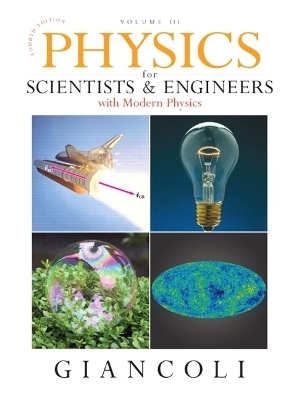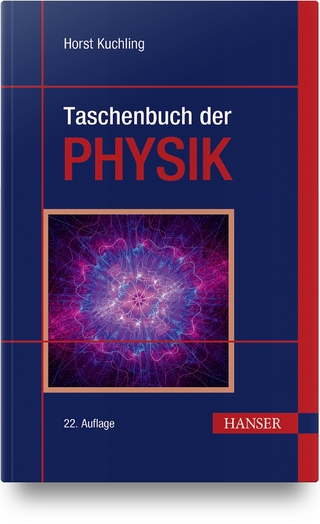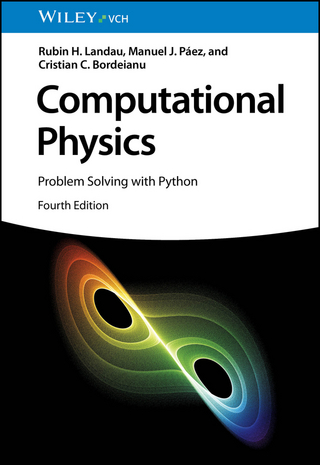
Physics for Scientists & Engineers with Modern Physics, Volume 3 (Chapters 36-44)
Pearson (Verlag)
978-0-13-227400-5 (ISBN)
- Titel erscheint in neuer Auflage
- Artikel merken
This long-awaited and extensive revision maintains Giancoli's reputation for creating carefully crafted, highly accurate and precise physics texts. Physics for Scientists and Engineers combines outstanding pedagogy with a clear and direct narrative and applications that draw the student into the physics. The new edition also features an unrivaled suite of media and on-line resources that enhance the understanding of physics.
This book is written for students. It aims to explain physics in a readable and interesting manner that is accessible and clear, and to teach students by anticipating their needs and difficulties without oversimplifying.
Physics is a description of reality, and thus each topic begins with concrete observations and experiences that students can directly relate to. We then move on to the generalizations and more formal treatment of the topic. Not only does this make the material more interesting and easier to understand, but it is closer to the way physics is actually practiced.
Douglas C. Giancoli obtained his BA in physics (summa cum laude) from UC Berkeley, his MS in physics at MIT, and his PhD in elementary particle physics back at the UC Berkeley. He spent 2 years as a post-doctoral fellow at UC Berkeley’s Virus lab developing skills in molecular biology and biophysics. His mentors include Nobel winners Emilio Segrè and Donald Glaser. He has taught a wide range of undergraduate courses, traditional as well as innovative ones, and continues to update his textbooks meticulously, seeking ways to better provide an understanding of physics for students. Doug’s favorite spare-time activity is the outdoors, especially climbing peaks. He says climbing peaks is like learning physics: it takes effort and the rewards are great.
NOTE: CHS 36-44 NOT FINAL; TOC TAKEN FROM PSE3
CHAPTER 36: SPECIAL THEORY OF RELATIVITY
36-1 Galilean—Newtonian Relativity
*36-2 The Michelson-Morley Experiment
36-3 Postulates of the Special Theory of Relativity
36-4 Simultaneity
36-5 Time Dilation and the Twin Paradox
36-6 Length Contraction
36-7 Four-Dimensional Space-Time
36-8 Galilean and Lorentz Transformations
36-9 Relativistic Momentum and Mass
36-10 The Ultimate Speed
36-11 Energy and Mass; E=mc2
36-12 Doppler Shift for Light
36-13 The Impact of Special Relativity
SUMMARY
QUESTIONS
PROBLEMS
GENERAL PROBLEMS
CHAPTER 37: EARLY QUANTUM THEORY AND MODELS OF THE ATOM
37-1 Planck’s Quantum Hypothesis
37-2 Photon Theory of Light and the Photoelectric Effect
37-3 Photons and the Compton Effect
37-4 Photon Interactions; Pair Production
37-5 Wave-Particle Duality; the Principle of Complementarity
37-6 Wave Nature of Matter
*37-7 Electron Microscopes
37-8 Early Models of the Atom
37-9 Atomic Spectra: Key to the Structure of the Atom
37-10 The Bohr Model
37-11 DeBroglie’s Hypothesis Applied to Atoms
SUMMARY
QUESTIONS
PROBLEMS
GENERAL PROBLEMS
CHAPTER 38: QUANTUM MECHANICS
38-1 Quantum Mechanics—A New Theory
38-2 The Wave Function and Its Interpretation; the Double-Slit Experiment
38-3 The Heisenberg Uncertainty Principle
38-4 Philosophic Implications; Probability Versus Determinism
38-5 The Schrodinger Equation in One Dimension—Time-Independent Form
*38-6 Time-Dependent Schrodinger Equation
38-7 Free Particles; Plane Waves and Wave Packets
38-8 Particle in an Infinitely Deep Square Well Potential (a Rigid Box)
*38-9 Finite Potential Well
38-10 Tunneling through a Barrier
SUMMARY
QUESTIONS
PROBLEMS
GENERAL PROBLEMS
CHAPTER 39: QUANTUM MECHANICS OF ATOMS
39-1 Quantum-Mechanical View of Atoms
39-2 Hydrogen Atom: Schrodinger Equation and Quantum Numbers
39-3 Hydrogen Atom Wave Functions
39-4 Complex Atoms; the Exclusion Principle
39-5 The Periodic Table of Elements
39-6 X-Ray Spectra and Atomic Number
*39-7 Magnetic Dipole Moments; Total Angular Momentum
*39-8 Fluorescence and Phosphorescence
*39-9 Lasers
*39-10 Holography
SUMMARY
QUESTIONS
PROBLEMS
GENERAL PROBLEMS
CHAPTER 40: MOLECULES AND SOLIDS
40-1 Bonding in Molecules
40-2 Potential-Energy Diagrams for Molecules
40-3 Weak (van der Waals) Bonds
40-4 Molecular Spectra
40-5 Bonding in Solids
40-6 Free-Electron Theory of Metals
40-7 Band Theory of Solids
40-8 Semiconductors and Doping
*40-9 Semiconductor Diodes
*40-10 Transistors and Integrated Circuits
SUMMARY
QUESTIONS
PROBLEMS
GENERAL PROBLEMS
CHAPTER 41: NUCLEAR PHYSICS AND RADIOACTIVITY
41-1 Structure and Properties of the Nucleus
41-2 Binding Energy and Nuclear Forces
41-3 Radioactivity
41-4 Alpha Decay
41-5 Beta Decay
41-6 Gamma Decay
41-7 Conservation of Nucleon Number and Other Conservation Laws
41-8 Half-Life and Rate of Decay
41-9 Decay Series
41-10 Radioactive Dating
41-11 Detection of Radiation
SUMMARY
QUESTIONS
PROBLEMS
GENERAL PROBLEMS
CHAPTER 42: NUCLEAR ENERGY: EFECTS AND USES OF RADIATION
42-1 Nuclear Reactions and the Transmutations of Elements
42-2 Cross Section
42-3 Nuclear Fission; Nuclear Reactors
42-4 Fusion
42-5 Passage of radiation through matter; Radiation Damage
42-6 Measurement of Radiation—Dosimetry
*42-7 Radiation Therapy
*42-8 Tracers
*42-9 Imaging by Tomography: CAT Scans, and Emission Tomography
*42-10 Nuclear Magnetic Resonance (NMR) and Magnetic Resonance Imaging (MRI)
SUMMARY
QUESTIONS
PROBLEMS
GENERAL PROBLEMS
CHAPTER 43: ELEMENTARY PARTICLES
43-1 High-Energy Particles
43-2 Particle Accelerators and Detectors
43-3 Beginnings of Elementary Particle Physics–Particle Exchange
43-4 Particles and Antiparticles
43-5 Particle Interactions and Conservation Laws
43-6 Particle Classification
43-7 Particle Stability and Resonances
43-8 Strange Particles
43-9 Quarks
43-10 The “Standard Model”: Quantum Chromodynamics (QCD) and the Electroweak Theory
43-11 Grand Unified Theories
SUMMARY
QUESTIONS
PROBLEMS
GENERAL PROBLEMS
CHAPTER 44: ASTROPHYSICS AND COSMOLOGY
44-1 Stars and Galaxies
44-2 Stellar Evolution; the Birth and Death of Stars
44-3 General Relativity: Gravity and the Curvature of Space
44-4 The Expanding Universe
44-5 The Big Bang and the Cosmic Microwave Background
44-6 The Standard Cosmological Model: Early History of the Universe
44-7 The Future of the Universe?
SUMMARY
QUESTIONS
PROBLEMS
GENERAL PROBLEMS
| Erscheint lt. Verlag | 9.9.2008 |
|---|---|
| Sprache | englisch |
| Maße | 10 x 10 mm |
| Gewicht | 826 g |
| Themenwelt | Naturwissenschaften ► Physik / Astronomie |
| ISBN-10 | 0-13-227400-0 / 0132274000 |
| ISBN-13 | 978-0-13-227400-5 / 9780132274005 |
| Zustand | Neuware |
| Informationen gemäß Produktsicherheitsverordnung (GPSR) | |
| Haben Sie eine Frage zum Produkt? |
aus dem Bereich


